Did PeeWee make the man, or did Wayne White make PeeWee? One thing’s for sure, this former Hollywood set designer is still using humor and wit to define art. Dirty Laundry spoke with White about his life and loves in show biz and his most recent transition into fine art.


All That Fake Laughin for Nothin
Acrylic on Offset Lithograph
Why do you make art?
Wow, well it’s all I’ve ever wanted to do. It’s all I’ve ever known. It’s just an indivisible part of my consciousness on Earth. It’s my earliest memories. There’s no “why,” it’s just something that I drifted into naturally. It’s completely instinctive with me, it really is. It’s something I found out I could do and I enjoyed it, and I still enjoy it.
What is the role of humor in art, and have you seen it change over time?
I use humor because I think it’s one of the more effective ways of communicating the truth. A lot of times truth-telling can be kind of preachy or didactic or self-righteous and it turns people off. And it’s just not effective. But humor just activates everything. It just makes it more enjoyable, more accessible. It’s something I kind of had to find out the hard way, through trial and error. For years I thought of myself as very serious. I wanted to be a very serious, deep artist, as all young people do. But then when I really examined it, and told the truth about myself, I found that humor was something I just kind of instinctively went toward. That word comes up a lot with me—instinctive. It’s what I follow. I follow instincts instead of intellectual ideas. I really don’t think the artist is an intellectual. I believe that the artist is a set of nerves, nerve endings. That’s what an artist is.
As far as humor in art, it’s always been there. It’s certainly something I didn’t innovate or discover. I’m just part of a grand tradition of using humor, wit, parody and satire to convey things. It’s been going on for centuries, and I think it will always be there because people need it. People need it, I don’t know why. It’s just very human, very basic.
I follow instincts instead of intellectual ideas. I really don’t think the artist is an intellectual. I believe that the artist is a set of nerves, nerve endings. That’s what an artist is.
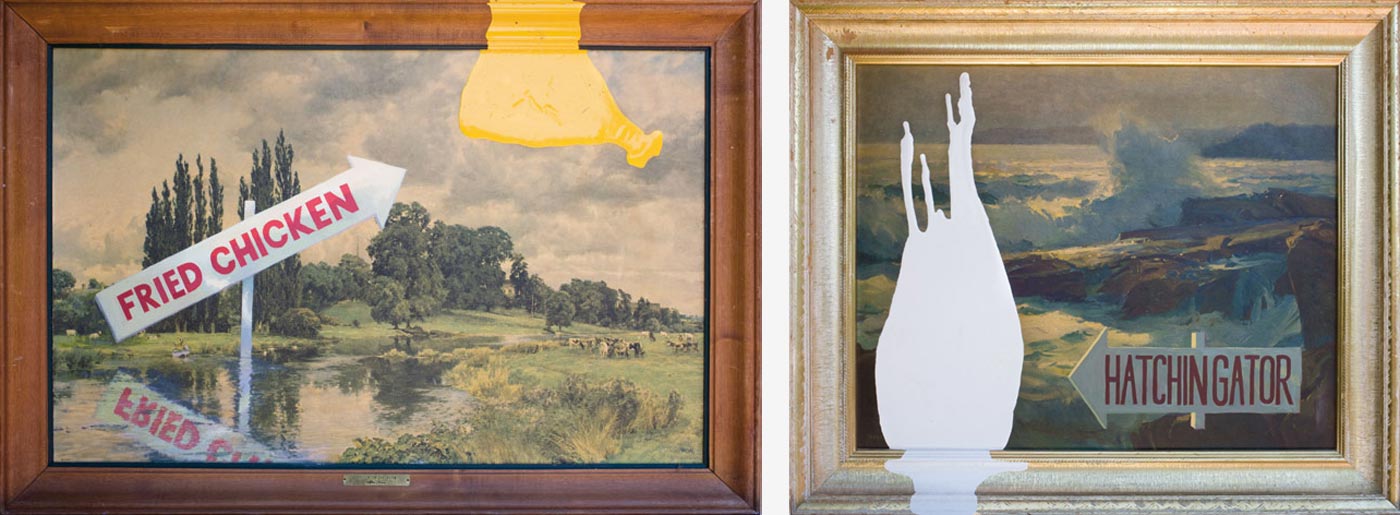

Fried Chicken, 27.5 x 41.25in, Enamel on Offset Lithograph, 2002
Hatchin Gator,31.5 x 37in, Enamel on Offset Lithograph, 2002
What was teenage Wayne White like?
He was actually kind of humorless. I was angry. I was an angry young man. I was stuck in Chattanooga, TN and the smaller town, Hixson, TN, just north of Chattanooga. There weren’t a lot of outlets for creativity and I felt very misunderstood. This was the 70s in the South, and I was an angry young man. I took out the anger in many different ways — I was a juvenile delinquent, I was a stoner, I drove too fast and I took crazy risks, like a lot of young men do. So yeah, I was a classic angry young man and I enjoyed it, I really did. I had a lot of energy and frustration, so the anger was a release valve for me. Those years still linger for me, and it’s taken a long time to get over all the anger.
So what would teenage Wayne White say to 2013 Wayne White?
He would say “Man, I’m so glad you made it.” He’d be very happy for me because I’m living the dream that I always wanted—to be an artist.
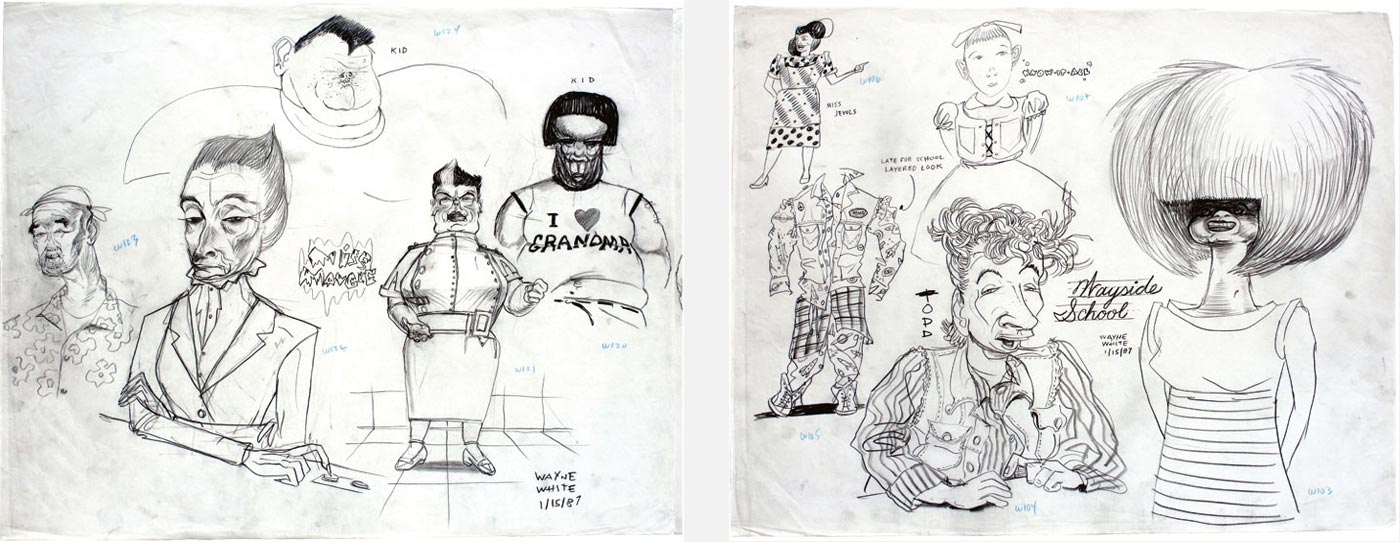

Wayside School, 19 x 24in, Pencil on Paper, 1987
Your work and even your personality have always had a fun, child-like quality. At what point did you realize you were an adult?
That hasn’t come yet. Still waiting. I’m 55 years old, you know, I’m late-middle-aged and I don’t feel any different than I did as a young man. There’s absolutely no difference at all. But if you really wanted to say what made me feel like an adult, I guess it was when my kids were born and I realized there are a lot more important things in life than worrying about yourself. It’s time to start worrying about somebody else and start bringing them up. So I guess that’s being an adult for me—kind of getting over yourself to realize that you have to prepare the world for the next generation.
When and why did you first start incorporating different characters into your work?
Well, my original idea of an artist was a cartoonist, and I think that’s true of a lot of American kids. It’s your first glimpse at what it is to be a working artist because we’re around comics more than anything, especially me in a small town in the 60s. So cartooning is naturally storytelling and creating characters, and that’s where the love of that all began. I loved comics, MAD Magazine, Charlie Brown, Robert Crumb and so forth. So I started creating characters and telling stories when I was a kid trying to be a cartoonist. I was the cartoonist at my junior high newspaper and it all started from there. And that’s still a big part of my work today—creating characters and telling stories. Even in the word paintings I do, that’s a narrative in its own way. A lot of the statements I make in these paintings are not necessarily me, but a character that I’m playing. It’s the voices of different characters and people.
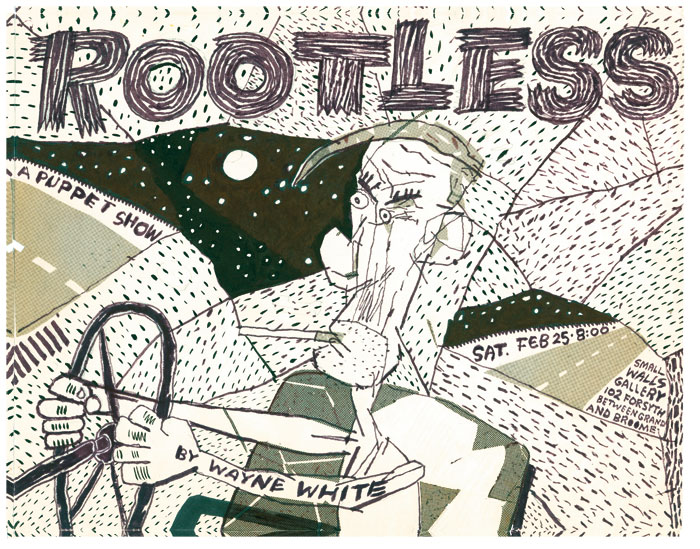

Rootless Puppet Show Poster
The puppet shows I’ve done for years, of course, those are naturally stories and characters, and that all comes directly out of my years as a cartoonist. When I went to art school and trained as a painter, I gave up wanting to become a cartoonist. But the minute I got out of college I went back to being a cartoonist because I saw RAW magazine in the 80s and what Art Spiegelman was doing with this new generation of underground comics. That’s also why I moved to New York in the 80s. I was there for about four or five years and that’s how I met my wife, Mimi Pond — world-famous Mimi Pond. Even today I still have lots of cartoonist friends, probably more cartoonist friends than painters or anything else. Comics, cartooning, and narrative art was, is, and always will be a big part of my world. I’d love to draw comics one day again, if I can find the time.
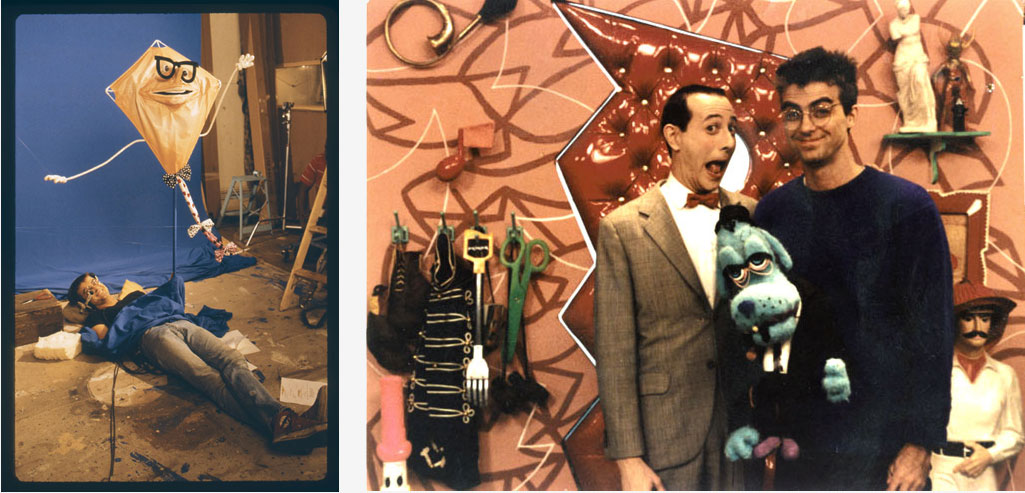

Photos from the set of PeeWee’s Playhouse
TV Series, 1986-1991
It’s been over 20 years since the show aired, do you think PeeWee’s Playhouse was defined by the 80s, or were the 80s defined by PeeWee’s Playhouse?
I think it helped define the 80s. It was a very important cultural phenomenon of that time, and it changed TV. It changed the face of kids’ television and all types of television as far as set design and the whole sensibility of it. So it definitely helped define the 80s.
How does PeeWee’s Playhouse stand up among today’s kid culture and what kids are watching in 2013?
Well, I think it had an influence that still reverberates today. Yo Gabba Gabba is definitely one of the children of PeeWee’s Playhouse. Adult Swim on Cartoon Network is not necessarily for children, but that is another product of PeeWee’s Playhouse. And it’s watched by and created by 30-somethings that grew up as children watching PeeWee’s Playhouse. That whole kind of ironic, deconstructed look at cartoons and so-called children’s entertainment has affected all sorts of things—rock videos, fashion, etc. The generation that grew up watching PeeWee is now creating movies and TV shows themselves, and it’s surely on their minds a lot. So it has a lasting influence, definitely.


Dirty Dog, PeeWee’s Playhouse, 11 x 14in, Pencil on Paper, 1987
Furniture, PeeWee’s Playhouse, 11 x 14in, Pencil on Paper, 1986
Conky, PeeWee’s Playhouse, 11 x 14in, Pencil on Paper, 1987
How does Hollywood treat artists?
Hollywood will use you as long as they need you, and then if they don’t need you anymore it’s over and that’s that. That’s the way it always has been and if you understand that game, then you’ll play it accordingly and not be too bitter when your time is up. There’s definitely a shelf-life for you in Hollywood, and it’s good and it’s bad. It’s one of the biggest employers of artists in our culture — an artist can always find work here, and that’s why I came here. But have no illusions about it, it’s a factory. And they need you for what they want, not what you want. If you’re willing to play the game that way, then jump in. You can make some decent money, and apply your craft. But the odds that you’re going to have your vision realized in Hollywood are very low. Most artists find that it’s just a job.
How would you differentiate between the work you’ve done for yourself and the work you’ve done for a production. You seem to blur the line a little bit, is there a difference?
Oh yeah, there’s definitely a difference. The work I do for myself, I do exactly what I want to do and nobody gives me notes, nobody has an opinion. When you work for Hollywood, everybody has an opinion and you have to change things according to their opinions. No artist wants to do that. You do it because you want to make money. But when I’m doing my own thing, nobody tells me what to change, and it’s as simple as that.
How does working in a creative group differ from working independently, and which do you prefer?
I did learn a lot of things from Hollywood. The first is how to work with a group of people to create something. You naturally can’t work alone in Hollywood if you’re designing and building a set, it takes a whole army of people. So I transferred those kind of management skills over into the art world and now I go around to museums and I hire groups of people to help me make my own creations. Just recently, in Oklahoma City, I made these three giant puppets that fill a room. It’s a big cubist cowboy rodeo called “Halo Amok” and it’s up until September at the Oklahoma Museum of Art. So I like to work with a group of creative people, especially when I have to have them, when the scale of the work is so huge. So I don’t mind groups at all and I learned how not to do it Hollywood, I learned how not to treat people.
Sometimes I think, “What would Hollywood do?” and then I do the opposite. I treat the artists with respect and let them experiment and bring their ideas along. I try to be open minded, everything that Hollywood wasn’t. But like I said, that’s the way Hollywood is and always will be, and if you learn to play the game you can get by. But I started playing the game and I got tired of playing on teams that I didn’t want to play on, so I went off and made my own teams.


I Ain’t Crazy
Acrylic on Offset Lithograph
2001
Sometimes I think, “What would Hollywood do?” and then I do the opposite. I treat the artists with respect and let them experiment and bring their ideas along. I try to be open minded, everything that Hollywood wasn’t.
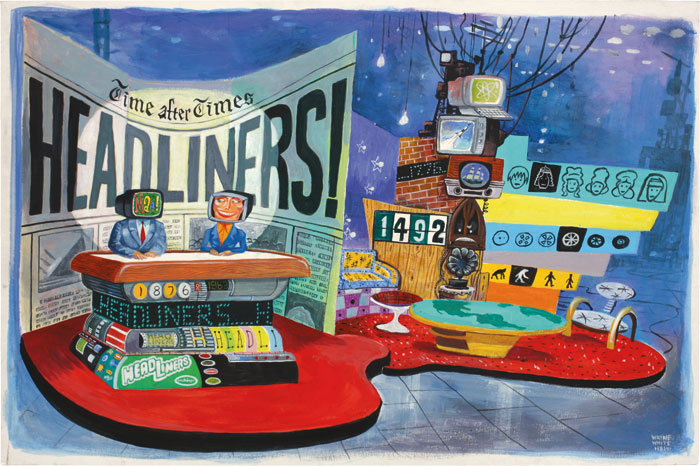

Headliners
Production Painting
Especially with Hollywood, there’s always the stress and reality of failure. For those times when the shows weren’t successful, what did you take away from those experiences?
The thing about Hollywood is, it’s mostly failure—like life. Life is mostly failure. Success is sort of a rarity, but when it’s great, it seems to overshadow all of that failure, and it looks like it’s the only thing but it’s not. So much of life is failure and learning from your mistakes. You know, most people make a whole career in Hollywood making one failure after another. Yet it’s steady work, and nobody puts you down for it. There are tons of pilots that are made every year for TV that never see the light of day. There are tons of projects that never even get beyond the drawing board. But it’s steady work, so you kind of learn to roll with the punches and know that most of the things you’re going to try aren’t going to pan out, but you can always learn something from them. Why they didn’t pan out or just the process of creating it was satisfaction enough and you don’t always have to have a big successful payout to be happy in life. You can be happy with the process. And Hollywood is just one big process—people constantly trying to throw things up against the wall and most of it doesn’t stick.
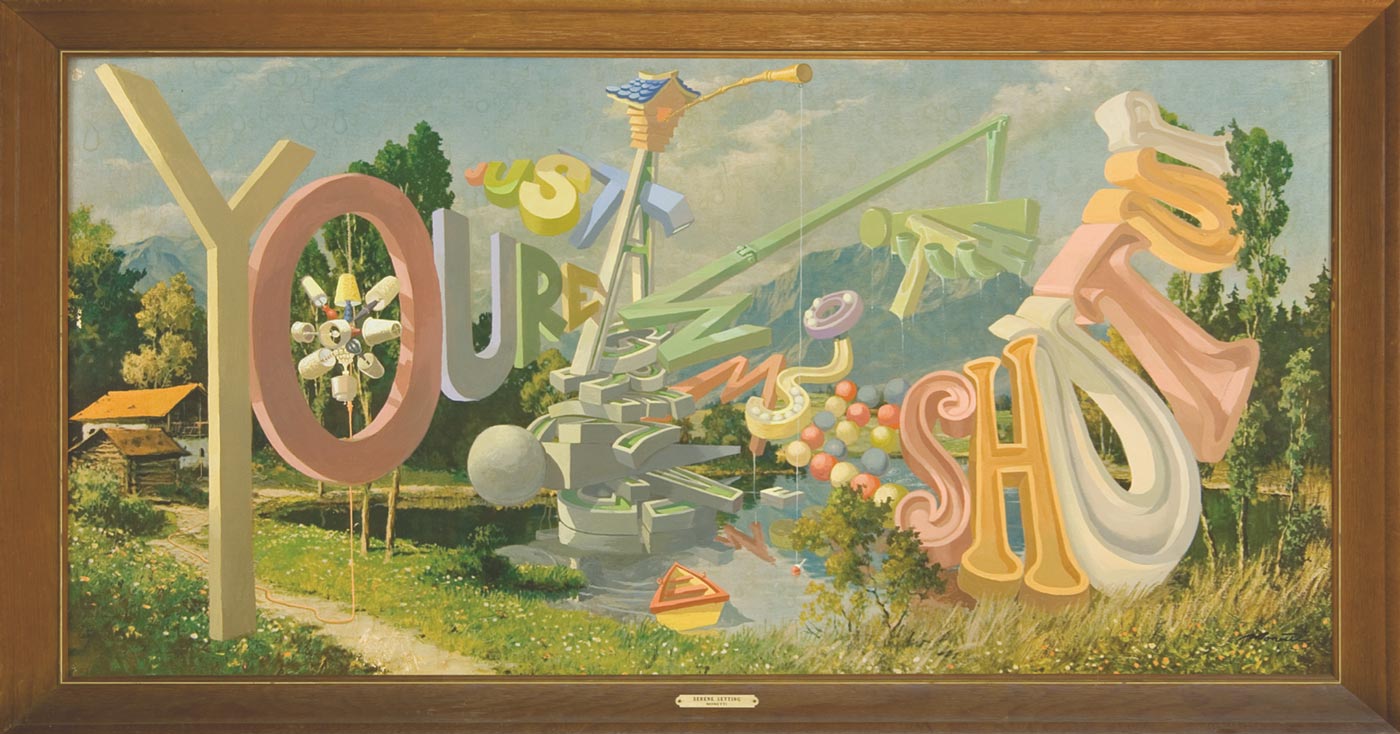

You’re Just Agreeing With Me So I’ll Shut Up
27.25 x 51.5in
Acrylic on Offset Lithograph
2006
Ever since I was a kid I used to draw letters even before I could read or write because I thought they looked liked people and characters and houses and things. And they are, that’s the origin of them — they’re just shorthand for the symbols of the world.
When did you start the word paintings?
I started the word paintings about 14 years ago, and they stemmed out of the fact that I had gone back to painting for myself after years of set designing and puppeteering. I really needed to nurture the painting again, I’ve always loved painting. And of course all of those years of cartooning and storytelling, I eventually wanted to use words to tell little stories and write little poems and do little short narrative things, so the two kind of came together as the word paintings. I love typography, I love just the forms of letters, and I always have. Ever since I was a kid I used to draw letters even before I could read or write because I thought they looked liked people and characters and houses and things. And they are, that’s the origin of them — they’re just shorthand for the symbols of the world. They started as this visual shorthand and evolved into language. I was a sign painter too, as a kid. So the love of typography, wanting to tell a story, trying to find a way of painting that nobody else was quite doing (that’s how the thrift store things came in there, nobody else was really doing that), it all luckily just kind of came together.
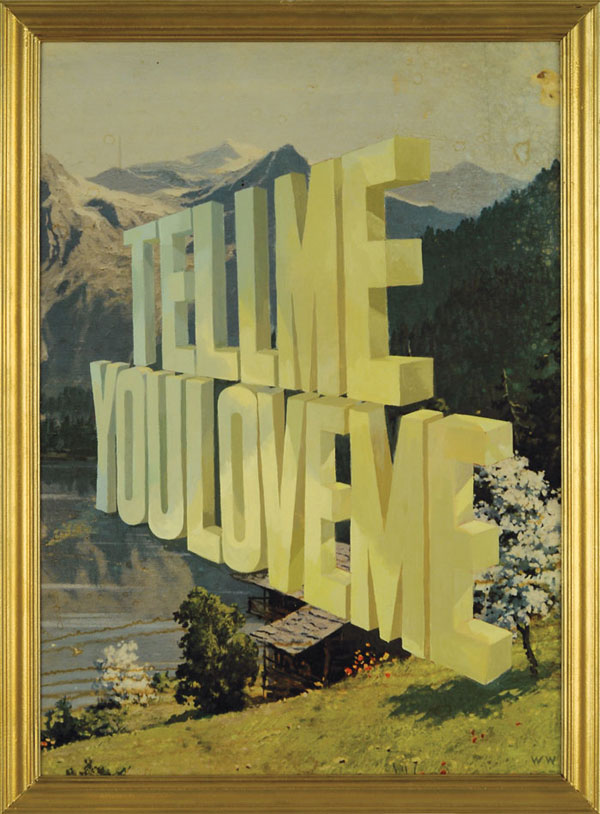

Tell Me You Love Me
Acrylic on Offset Lithograph
What kind of response did you get from the work?
The response was immediate. That’s when I knew I was onto something. I had never had anybdy respond to something so immediate. The minute I started showing them, people were very interested, it was great. Nothing has ever taken off so quickly for me, ever.
Are you ever 100 percent satisfied with your work?
No. Never. And I never will be. That’s sort of a curse and a blessing. It keeps you on your toes and keeps the work fresh, and hopefully it keeps you interesting as an artist so you don’t rest on your laurels. Never rest as an artist, that’s one thing you‘ve got to realize. The minute you get satisfied with yourself, that’s when the work starts to fall apart. I’m just naturally (here comes that word again) instinctively never satisfied.
What’s it like to be in such an artistic household?
It’s great. I don’t know any other way of life, so I can’t really compare it to anything, but it’s something I’ve always wanted. I’ve had one form of “artistic household” or another ever since I left home. Living with friends in college, girlfriends, communal living with other artists, roommates in New York with other artists. Now I’m married to an artist and my children are artists so it’s just a living condition I’ve always wanted and it’s great. It’s great to be around other artists, relate to each other, and bond with each other over the art.
Is there ever a level of competition?
There can be, yeah. I mean some people say “No, I don’t want to live with other artists.” They call it “sleeping with the enemy.” But yeah, the competition can be there and be kind of a downside sometimes. Egos can clash. But the good stuff definitely outweighs the bad.
Never rest as an artist, that’s one thing you‘ve got to realize. The minute you get satisfied with yourself, that’s when the work starts to fall apart.
What advice do you have for young and emerging artists?
Well, here’s the one piece of advice that I always give. And it’s not very sexy and it’s not very exciting. It’s pretty much common sense. Plain speaking, Never. Give. Up. Having persistence is the number one talent you’ve got to have as an artist. As long as you’re persistent, all of that other stuff — your wit, your talent, your craft, all of that stuff will take care of itself. It all stems from the golden key, the energy source of persistence. And that sounds very obvious, but when you think about it, it’s the strongest and best advice I can give. If you have the sense that you’re never going to give up, that’s a faith you can always go back to. It keeps you going. Because when you give up, it’s over and that’s that. And nobody cares. Nobody cares, you’ve got to realize that too. You’re the only one who cares. Don’t go around thinking “Well, if I give up, everybody will be sorry.” No they won’t. They have their own problems. Or “If I go on, I’ll show them!” No, they don’t really care. Just do it for you and believe in yourself, and never give up.


I Took Off Work And Came All The Way Down Here, Acrylic on Offset Lithograph
I’m Lost On A Spaceship Momma, 26 x 32in, Acrylic on Offset Lithograph, 2006
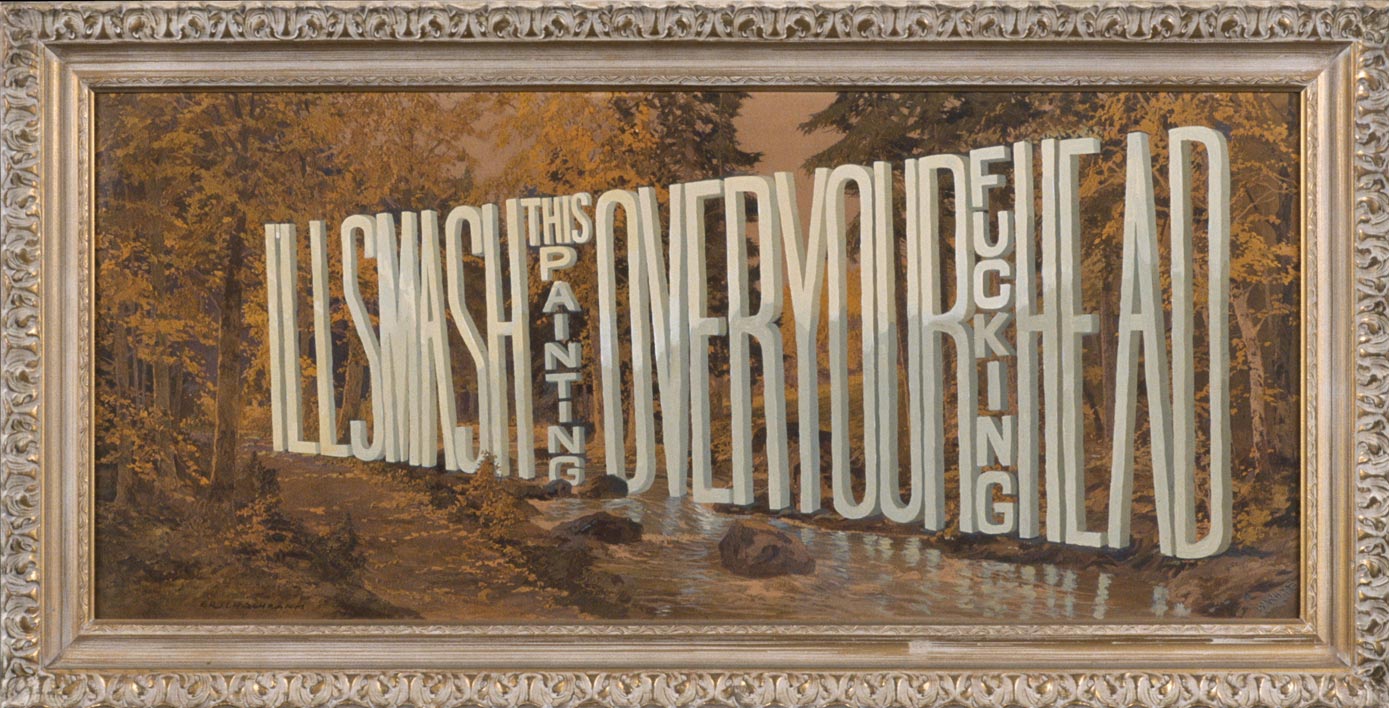

I’ll Smash This Painting Over Your Fucking Head, 27 x 53.5in, Acrylic on Offset Lithograph, 2002